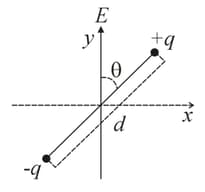Embibe Experts Solutions for Chapter: Electrostatics, Exercise 2: Level 2
Embibe Experts Physics Solutions for Exercise - Embibe Experts Solutions for Chapter: Electrostatics, Exercise 2: Level 2
Attempt the practice questions on Chapter 12: Electrostatics, Exercise 2: Level 2 with hints and solutions to strengthen your understanding. Physics Crash Course NEET solutions are prepared by Experienced Embibe Experts.
Questions from Embibe Experts Solutions for Chapter: Electrostatics, Exercise 2: Level 2 with Hints & Solutions
An electric dipole is placed on axis in proximity to a line charge of linear charge density Line charge is placed on axis and positive and negative charge of dipole is at a distance of and from the origin respectively. If total force of is exerted on the dipole, find out the amount of positive or negative charge of the dipole.
Two particles and having charges and respectively are held fixed with a separation of At what position a third charged particle should be placed so that it does not experience a net electric force ?

Two charges of and are placed apart. The ratio of forces exerted by both the charges on each other will be
The magnitude of electric field intensity is such that, an electron placed in it would experience an electrical force equal to its weight, is given by
A point charge is placed at a point inside a hollow conducting sphere. Which of the following electric force pattern is correct?
The net electric charge enclosed by a Gaussian surface of dipole is
An electric dipole having point charges and , separated by a fixed distance is kept under the influence of a uniform electric field , such that the axis of the dipole is making an angle with the direction of , as shown in the figure. If the electric dipole is allowed to rotate in the -plane with its center being stationary, what is the magnitude of the net torque acting on the electric dipole?

The plates of a parallel plate condenser are pulled apart with a velocity If at any instant mutual distance of separation is then the magnitude of the time of rate of change of electrostatic energy of the capacity depends on as follows: (potential difference between plates is kept constant)-
